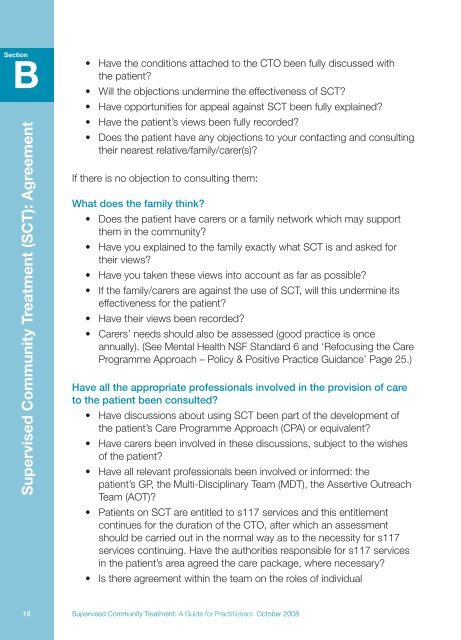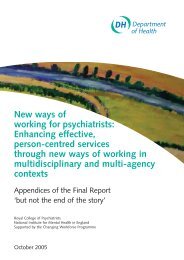Supervised Community Treatment: - Social Perspectives Network
Supervised Community Treatment: - Social Perspectives Network
Supervised Community Treatment: - Social Perspectives Network
You also want an ePaper? Increase the reach of your titles
YUMPU automatically turns print PDFs into web optimized ePapers that Google loves.
Section<br />
• Have the conditions attached to the CTO been fully discussed with<br />
the patient?<br />
professionals and carers for the patient’s care and has this been clearly<br />
communicated to the patient?<br />
• How will you arrange to monitor the patient’s progress in the community,<br />
including compliance with the conditions and early identification of any<br />
risk arising which might mean a need to recall the patient to hospital?<br />
Section<br />
<strong>Supervised</strong> <strong>Community</strong> <strong>Treatment</strong> (SCT): Agreement<br />
• Will the objections undermine the effectiveness of SCT?<br />
• Have opportunities for appeal against SCT been fully explained?<br />
• Have the patient’s views been fully recorded?<br />
• Does the patient have any objections to your contacting and consulting<br />
their nearest relative/family/carer(s)?<br />
If there is no objection to consulting them:<br />
What does the family think?<br />
• Does the patient have carers or a family network which may support<br />
them in the community?<br />
• Have you explained to the family exactly what SCT is and asked for<br />
their views?<br />
• Have you taken these views into account as far as possible?<br />
• If the family/carers are against the use of SCT, will this undermine its<br />
effectiveness for the patient?<br />
• Have their views been recorded?<br />
• Carers’ needs should also be assessed (good practice is once<br />
annually). (See Mental Health NSF Standard 6 and ‘Refocusing the Care<br />
Programme Approach – Policy & Positive Practice Guidance’ Page 25.)<br />
Have all the appropriate professionals involved in the provision of care<br />
to the patient been consulted?<br />
• Have discussions about using SCT been part of the development of<br />
the patient’s Care Programme Approach (CPA) or equivalent?<br />
• Have carers been involved in these discussions, subject to the wishes<br />
of the patient?<br />
• Have all relevant professionals been involved or informed: the<br />
patient’s GP, the Multi-Disciplinary Team (MDT), the Assertive Outreach<br />
Team (AOT)?<br />
• Patients on SCT are entitled to s117 services and this entitlement<br />
continues for the duration of the CTO, after which an assessment<br />
should be carried out in the normal way as to the necessity for s117<br />
services continuing. Have the authorities responsible for s117 services<br />
in the patient’s area agreed the care package, where necessary?<br />
• Is there agreement within the team on the roles of individual<br />
Planning the ongoing review of SCT<br />
• Are dates for review known to all relevant stakeholders: the<br />
patient, nearest relative, other family/carers, where appropriate,<br />
and professionals?<br />
• Have you been able to set up services which empower the patient<br />
and look towards their future?<br />
• Has the patient been offered inclusive day services, education, training<br />
or work-related activities?<br />
Once agreement is reached with all of the care team and the patient,<br />
then the CTO is made – see AMHP and RC responsibilities.<br />
Summary<br />
Overview of what needs to be done at this stage, in the<br />
in-patient setting<br />
• Consult the patient<br />
• Talk and listen to the patient’s family, advocate (or IMHA when<br />
this service is available) and carers, if appropriate<br />
• Make a full clinical assessment and assess the risk of<br />
deterioration if the patient is discharged from in-patient care<br />
• Decide that the SCT criteria are met and that this is the best<br />
option for this patient<br />
• Inform the patient<br />
• Determine with the patient the conditions which the CTO will<br />
contain<br />
• Involve the <strong>Community</strong> Mental Health Team (CMHT) and family/<br />
carers, as appropriate, in the care planning process<br />
• Involve the patient’s GP in care planning process<br />
• Up-date the patient’s CPA plan (or equivalent) and make contact<br />
with the right agencies for providing after-care<br />
<strong>Supervised</strong> <strong>Community</strong> <strong>Treatment</strong> (SCT): Agreement<br />
18 <strong>Supervised</strong> <strong>Community</strong> <strong>Treatment</strong>: A Guide for Practitioners October 2008<br />
October 2008 <strong>Supervised</strong> <strong>Community</strong> <strong>Treatment</strong>: A Guide for Practitioners 19










